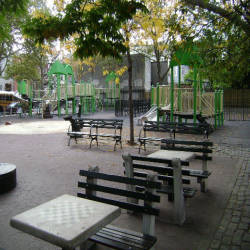Introduction to Washington Square Park
Among New York’s most famous parks, Washington Square Park stands out as a cultural landmark and an urban icon. Located in the heart of Greenwich Village, the park is not only a green oasis but also a space where history, culture, and community life intersect.
For decades, it has been a gathering place for residents, students, street performers, and visitors from around the world. Often described as the “cultural heart of Greenwich Village,” the park embodies the city’s spirit of creativity, activism, and diversity.
Location and size
Washington Square Park is situated in Lower Manhattan’s Greenwich Village. Covering 9.75 acres (39,500 m²), it is managed by the New York City Department of Parks and Recreation
. Unlike the vast Central Park, Washington Square Park is relatively small in size but rich in activity, energy, and symbolism.
Surrounding areas
The park is bordered by four main streets, forming a complete square:
Washington Square North (Waverly Place) –
lined with historic buildings, many now owned by New York University (NYU).
Washington Square East (University Place) – directly connected with NYU’s academic and residential facilities.
Washington Square South (West 4th Street) – bustling with cafes, shops, and restaurants.
Washington Square West (MacDougal Street) – known for its vibrant nightlife, jazz clubs, and historic venues that nurtured countless artists.
Architectural highlights and open space
Iconic landmarks
Two of the park’s most significant features include:
The Washington Square Arch:
Built in 1892 to commemorate the centennial of George Washington’s inauguration as the first U.S. president. Inspired by the Arc de Triomphe in Paris, it stands as the most recognizable symbol of the park and frequently appears in films, photographs, and literature.
The Central Fountain:
At the heart of the park, the large fountain has long been a focal point for community life – hosting performances, rallies, festivals, and casual gatherings.
Community spaces
Washington Square Park offers a variety of amenities for all ages:
Playgrounds for children.
Tree-lined walkways, flower beds, and shaded lawns.
Chess tables, benches, and picnic spots.
Numerous memorial statues and public artworks.
Surrounding buildings, once home to artists and families, have been purchased by New York University
, which has repurposed them into classrooms and dormitories – seamlessly blending academic life into the park’s environment.
Cultural and historical value
Memorial statues
The park commemorates important historical figures with statues, including:
George Washington – first U.S. president.
Giuseppe Garibaldi – Italian patriot and military leader.
Alexander Lyman Holley – a pioneering engineer in the U.S. steel industry.
Symbolic role
Washington Square Park has played a crucial role in New York’s cultural and political history. In the mid-20th century, it was a stage for countercultural movements, anti-war protests, and performances by legendary folk musicians such as Bob Dylan and Joan Baez.
Today, it remains a vibrant symbol of New York’s community life – a place for family picnics, student gatherings, cultural events, street performances, and simple relaxation. Its open and lively atmosphere continues to attract millions of visitors each year.
For many, Washington Square Park is not just a park but a symbol of freedom, creativity, and diversity – often compared with Central Park in terms of cultural importance, though unique in its character and history.
 Register
RegisterSign in Travel Agent
Sign in Supplier
Sign in Affiliate
Sign in Guru



 Washington Park, Brooklyn, NY 11205, USA
Washington Park, Brooklyn, NY 11205, USA